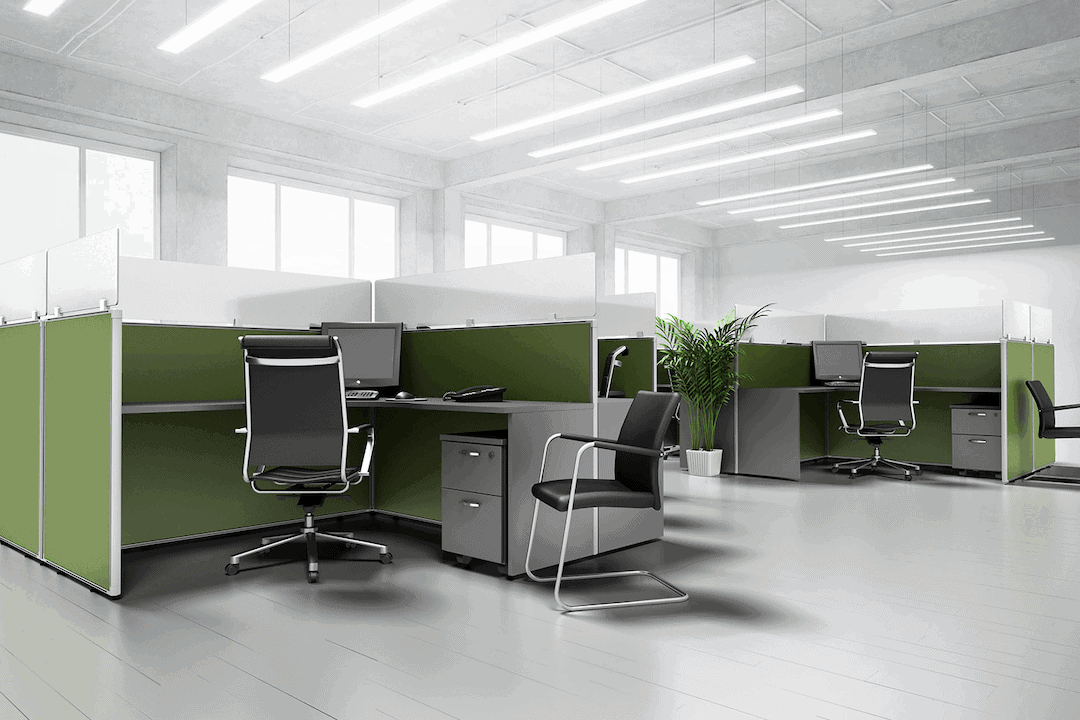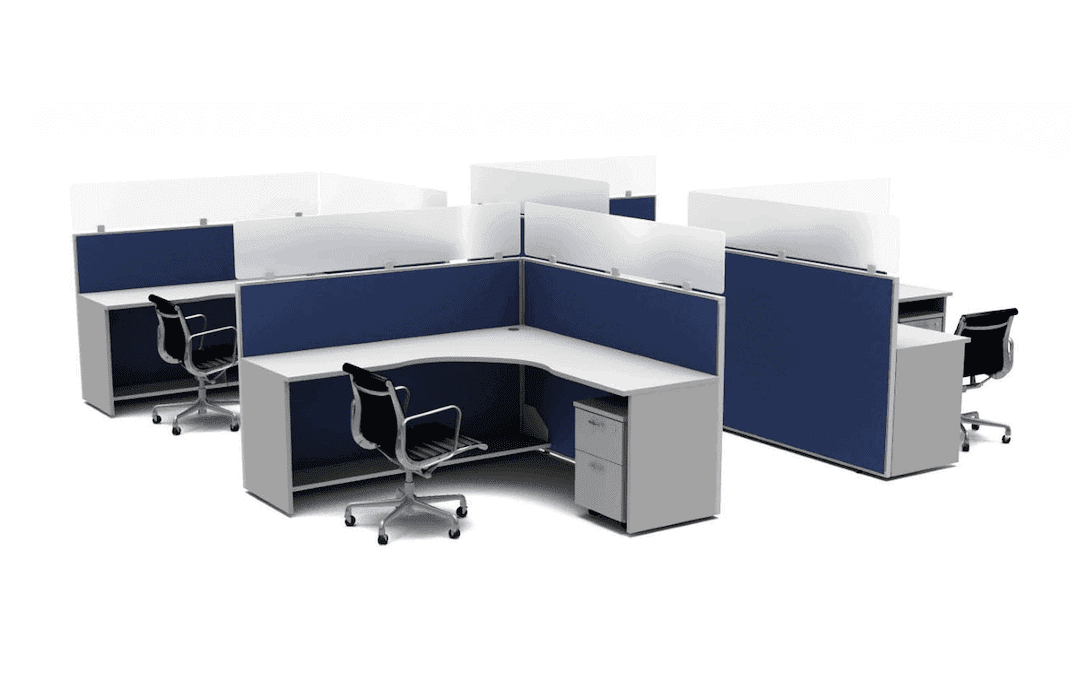We are learning how to live in a world forever changed by COVID-19. Many employees returned to work last year but are only in the office part-time, working from home the rest of the time. This modern hybrid-remote workforce has unique needs that previous office design trends did not account for. For example, employees today expect more space and privacy in the workplace to help limit the spread of germs and airborne viruses. Also, employers do not need as many workstations, because employees do not need dedicated workstations if they are only going into the office two or three days per week.
These changing needs have compelled many businesses to consider redesigning the office space to better suit the needs of the evolving workplace. The ever-popular open office does not provide employees the privacy and space they desire. Businesses are looking to adapt the open office design to include more dividers that create separation among employees. For this reason, the cubicle is making a comeback after it was jettisoned by the open office movement. Office designers are also using other office furniture pieces to create that separation. Examples include:
When you partner with office furniture and design professionals, they help you redesign your office layout and furniture to maximize your space, workforce productivity, and the needs of employees in today’s modern office setting. Let’s explore the two most prevailing needs in modern-office redesign:
Hybrid-Remote
While an entire staff that worked remotely exclusively would save companies a lot of money in overhead, we know that the office provides significant employee and productivity benefits. The important in-office employee productivity benefits that employers and designers should consider include:
Collaboration
While remote conferencing technology is great for collaboration, it does not quite reach the benefits of in-person collaborating. Typically, remote collaboration is structured or scheduled. In contrast, by being in the same office together employees are more likely to engage in unstructured collaboration that can solve problems more efficiently. These collaborations can happen during an impromptu conversation at lunchtime in the kitchen or dining area or while making small talk during a coffee break.
Social Connections
Team-building is an important component of productivity and collaboration. Unstructured collaborative interactions are more likely to happen when coworkers have healthy social relationships. As the Harvard Business Review describes, the office serves as the “Social Anchor” that helps encourage face-to-face interactions and “human moments.” Without in-person interactions, building a collaborative and knowledge-sharing team culture can be more challenging.
Office Design Considerations
Office design and furniture considerations used to be based on the idea that every employee would be in the office to work full-time and would need a permanent workstation. Most office workers now work from home at least part-time. That model has pros and cons. An obvious pro is that office space will cost less moving forward. For the same number of employees, fewer workstations and a smaller square footage are needed now. An obvious con is that it is now more complicated for businesses to plan offices. If you have 500 employees and employees are in the office 2 days per week on average, you would need approximately 200 workstations. But what if Wednesday is a much more popular day to be in the office? How many workstations do you need?
An office design and furniture dealer can help you plan for these possibilities, but solving these challenges is not easy.
Hoteling is one method that is used to help bridge the gap between assigned workstations and the open office. It is unassigned desk within shared office space, that can be used when an employee is in the office for a particular day.
When the in-office workforce is different each day, the office needs to be designed more flexibly. Naturally, workstations will be shared and not dedicated to one employee. Flexibility and shared workstations are elements that are commonly associated with an open office layout.
Today most companies want more social distancing than an open office can provide. A new layout may include more dividers, cubicles, and other break-out areas. A combination of collaborative spaces and private spaces meets the evolving needs of the modern workforce.
Designed for Human Needs
When they are aiming to strike a balance between collaboration and privacy, designers look to incorporate elements that enable social interactions. These elements could include a huddle room, a privacy pod, or just a semi-isolated alcove or a high-top table. Other options may be more casual furniture like couches or lounge chairs where workers can find a comfortable space to sit, focus, or collaborate.
Encourage Connections
With all of the effort and budgetary resource put into office design and furnishings, it is important to encourage collaboration and social interaction. Managers should ensure that when people are in the office they know that socializing and connecting with their colleagues is not only allowed but encouraged. Managers can reinforce this philosophy by spending time in the common areas themselves and participating in social interactions.
The Pandemic
Before the pandemic, open offices were squeezing more workers into smaller spaces by replacing cubicles with multi-person benches or workstations. Companies were able to fit more employees into less space and that layout required less furniture on a per-person basis. Today, people are leerier of spending a lot of time in close contact with others and prefer a little bit more personal space. Offices that have a layout conducive to social distancing are usually less open. They either have more space between employees or more dividers in place to minimize the virus’s ability to spread.
Designing office space in a Hybrid world
For many companies, meeting workplace needs in a COVID and post-COVID environment may require an office redesign. Although it may be a daunting thought, a new office design creates a safe and healthy office environment.
Employee safety and employee comfort absolutely must be at the center of office redesign. While the look of a new corporate office interior design is still important, any redesign to accommodate coronavirus health requirements will only be successful if employees feel safe returning to work, as many offices still have share space. Joyce Contract Interiors can work with you to redesign your office space in a way that shows your employees that they are your priority.
Establishing a healthy workspace begins with a good look at what office redesign has to offer. Whether you are building a more private office design or a shared-office space design, there are specifics to consider.
What does the future workplace look like?
The first step in redesigning office space in 2023 is to consider ongoing changes. While the business world may be slowly returning to a slightly more normal way of life, there are important restrictions and instructions that remain. Maintaining social distancing rules and increasing the cleanliness of shared spaces are still important employer responsibilities.
The ongoing changes may feel overwhelming, especially when there is still considerable anxiety and uncertainty about global conditions. However, we are all in this together. It is our goal at Joyce Contract Interiors to make any office redesign and transition as smooth as possible.
How can you create a healthy workplace through design? The way you redesign your office space can reinforce safe social-distancing habits and support individual concerns about separation and safety. An office-space design can cover many factors, and even small adjustments can make a big difference. Whether you are hoping to use a more open floor plan or to increase the closed nature of individual offices, there are office redesign choices that will help prevent the spread of the virus.
The way you redesign your office space can reinforce safe social-distancing habits and support individual concerns about separation and safety. An office-space design can cover many factors, and even small adjustments can make a big difference. Whether you are hoping to use a more open floor plan or to increase the closed nature of individual offices, there are office redesign choices that will help prevent the spread of the virus.
Creating a healthy workplace through design means considering both physical and emotional health. Redesigning office space to emphasize distance and cleanliness will ensure physical health. Psychological health will come from knowing that the office design is structured to prioritize employee wellness.
How do you redesign offices and use office space effectively?
While good office design mixes function, appeal, and comfort, the office redesign process will look a little different for every office. Most importantly, effective office design in current conditions means design that addresses employee fears and helps make coming to work a safe and comfortable decision for everyone.
There are some common factors that are present in each new office design. Important issues to consider include the orientation of various workstations, the use of screens to maintain distance, the height of each modular office desk and private office cubicle, and the availability of mobile dividers that can be used where needed and cleaned easily.
Office interior design now prioritizes separation between individuals, optimizing communication despite that separation. Many designs can be implemented by reworking existing office furniture layouts or by adding dividers or sneeze guards to work surfaces or panels. While the size of private offices had been shrinking, there have been recent increases in the size of those offices. As you redesign your office space, work with experts who not only specialize in corporate office interior design but have also been working hard with other businesses to make these same adjustments.
Selecting office furniture suited for a healthy environment
While cost and aesthetic appearance remain important considerations in selecting office furniture, distancing and safety are now pivotal to the design structure. Clean office space, modular office desks, modular office workstations, private office cubicles, private office desks, and private workstation systems are all examples of what shared office space design may now contain. Joyce Contract Interiors has a wide selection of these furniture types available to add to or update your current office.
What are the newest products for a healthy workspace?
There are more office furniture options available than ever before. At Joyce Contract Interiors, we stay up to date on all of the newest products, particularly those that help with social distancing and employee safety. One area to focus on is screen dividers and panels for desks. Made from easy-to-clean materials, these screens can be added to already existing office furniture, updating private office desks or private office cubicles that exist in your office today.
We also offer healthy office workstations and workspaces. These pieces are designed for multiple purposes, including room dividers, multi-person workstations, and private workstation systems. With laminate and glass separators and dividers, your employees will be near each other but separated by a protective barrier.
JCI can also provide healthy desk seating, healthy task seating, and healthy guest seating. While seating surfaces need to be easy to clean, the chairs must be comfortable to sit in, too. Our modular office desk options are adjustable and flexible to fit the office redesign that your office needs.
Why is design important in the workplace and how does it affect employees?
Keep in mind that proper office redesign is only part of the battle. Your employees are adjusting to a new work life and are experiencing all of the associated stress. A thoughtful and safe office setup helps them cope in an already difficult time.
Corporate office interior design impacts the way people feel when they walk into work. Office design can encourage relaxation, focus, comfort, and familiarity. The well-being of employees is directly affected by office design. Design impacts employee motivation, determines if an employee has access to the space and materials needed to get the job done, and influences how welcoming the workplace is. You can redesign your office space to promote all of these positive outcomes. Especially in the transition from working at home to returning to an office, there are many employee anxieties and concerns. An employer that focuses on office design helps employees feel more secure in the office. People spend the majority of their days at work. In the current conditions, it is imperative that office redesign supports the well-being and security of employees.
Joyce Contract Interiors is ready to help you redesign
We have a number of product solutions that will help build a corporate office interior design that is ready to function in a world so strongly impacted by the coronavirus. Our mission statement emphasizes that “our focus is on design and project management that consistently delivers value to our customers.”
Right now, health and safety are valued most by employers and employees alike. To move toward a more normal world and office space, we need to adjust what workspaces look like. Let our experts help you with that type of design. Contact us today to launch an office redesign for a hybrid world.


